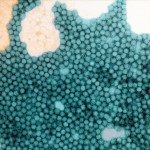Link to Pubmed [PMID] – 37910158
Link to DOI – 10.1099/jgv.0.001915
J Gen Virol 2023 Nov; 104(11):
Enteroviruses primarily affect young children with a varying severity of disease. Recent outbreaks of severe respiratory and neurological disease due to EV-D68 and EV-A71, as well as atypical hand-foot-and-mouth-disease due to CVA6, have brought to light the potency of enteroviruses to emerge as severe human pathogens. Enterovirus D111 (EV-D111) is an enteric pathogen initially detected in Central Africa in human and wildlife samples and was recently detected in environmental samples. The natural history and epidemiology of EV-D111 are poorly studied. Here, the presence of serum neutralizing antibodies to EV-D111 was estimated in human and wildlife samples from five countries. We report high prevalence of neutralizing antibodies measured against EV-D111 in human populations (range, 55-83 %), a proxy for previous infection, which indicates active virus circulation in absence of detection in clinical cases and a high number of undiagnosed infections. Notably, seroprevalence in samples from the UK varied by age and was higher in children and older adults (1-5 and >60 years old), but lower in ages 11-60. EV-D111 seroprevalence in apes and Old World monkeys was 50 % (33-66 %), which also suggests prior exposure and supports existing knowledge of enterovirus circulation in wild and captive apes and Old World monkeys. Generally, reported cases of infection likely underestimate the prevalence of infection particularly when the knowledge of community transmission is limited. Continued serologic surveillance and detection of EV-D111 in clinical and environmental samples will allow for a more robust assessment of EV-D111 epidemiology.



